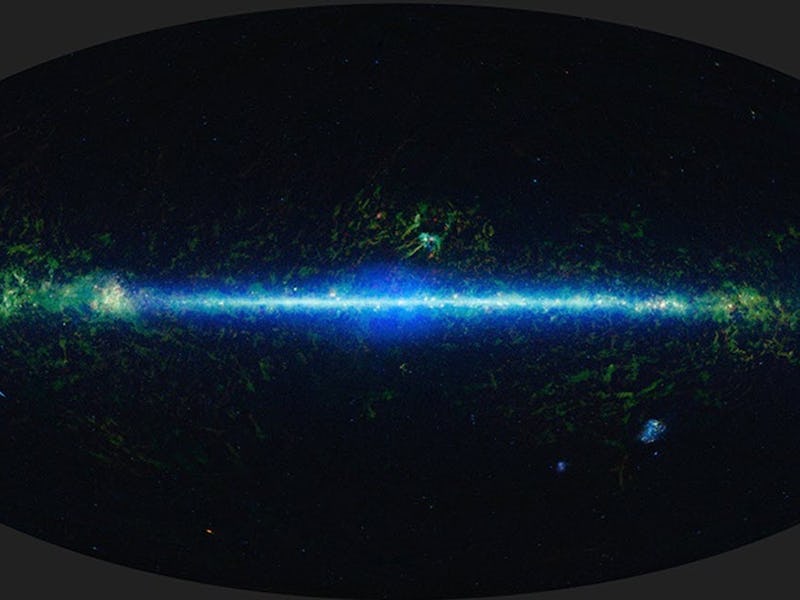In just 12 years, the universe has changed profoundly
NASA combined 18 all-sky images to create a timelapse of the night sky.

The Universe is over 13 billion years old, so a 12-year slice of that time might seem uneventful. But a timelapse movie from NASA shows how much can change in just over a decade. Stars pulse, asteroids follow their trajectories, and distant black holes flare as they pull gas and dust toward themselves.
NASA launched WISE — the Widefield Infrared Survey Explorer — in 2009. WISE found star clusters and thousands of dwarf planets and helped discover Earth’s Trojan asteroids, among other things. When WISE ran out of primary coolant in 2011, NASA put the spacecraft in hibernation. But some of the spacecraft’s infrared detectors still worked. So in 2013, they reactivated the mission as NEOWISE — Near-Earth Object Wide Field Infrared Survey Explorer. One of NEOWISE’s main goals was to characterize 2,000 known asteroids.
The spacecraft did these things by performing wide-field surveys of the sky. Every six months, NEOWISE completes one image of the night sky. NASA combined 18 of these all-sky images taken over a decade to create a timelapse of the night sky. Together they contain hundreds of millions of objects.
Watch the timelapse:
“If you go outside and look at the night sky, it might seem like nothing ever changes, but that’s not the case,” said Amy Mainzer, principal investigator for NEOWISE at the University of Arizona in Tucson. “Stars are flaring and exploding. Asteroids are whizzing by. Black holes are tearing stars apart. The Universe is a really busy, active place.”
One of the mission’s significant scientific contributions is its study of brown dwarfs. Brown dwarfs are not quite stars; they’re substellar objects on their way to becoming stars. But they never gathered enough mass to trigger hydrogen fusion. They’re smaller than stars and larger than the largest planets. Their masses span from about 13 to 80 Jupiter masses.
Astrophysicists theorized that brown dwarfs existed, but only infrared observations could find them. Infrared astronomy is difficult from Earth’s surface, though the 2MASS survey succeeded in finding some. Now we know of thousands of them, thanks to infrared observatories like WISE/NEOWISE.
Diving into brown dwarfs — Astrophysicists are interested in the coolest brown dwarfs because they bridge the gap between stars and planets. They’re spectral class Y brown dwarfs and emit very little energy. The coolest ones are a little more than room temperature. WISE discovered the Y-class brown dwarfs in 2011.
Brown dwarfs are too big to be planets but not quite massive enough to be stars.
NASA eventually combined data from WISE and NEOWISE into one catalog called CATWISE. In 2019, scientists searching through the catalog found CWISEP J1935-1546, an even colder brown dwarf with an estimated temperature of 270 to 360 K (?3–87 °C; 26–188 °F).
Citizen scientists have also played a role in NEO/NEOWISE’s brown dwarf activities. Citizen scientists helped find two of the most unusual brown dwarfs ever found. They’re called T-type subdwarfs, and scientists and volunteers found them in 2020 as part of the Backyard Worlds project.
In 2020, scientists working with NEOWISE discovered the strangest brown dwarf yet. They nicknamed it the “Accident” because they found it accidentally. The Accident is ancient — between 10 to 13 billion years old — and has very low metallicity. It’s so old that its metallicity reflects the early Universe rather than the modern Universe. Generations of stars have created heavier elements and spread them out into space over billions of years, so objects formed in more recent times have higher metallicity.
Though the Accident is the first of these ancient brown dwarfs ever found, it probably won’t be the last. There are likely many of them lurking in the darkness, maybe even still hiding in NEOWISE data.
The NEOWISE mission has lasted much longer than anticipated. When NASA launched it as WISE, they thought it would last about two years until its coolant ran out. But after re-commissioning it as NEOWISE, the mission has been going on for 10 years. Even WISE scientists are surprised at the mission’s length, and by the amount of data it’s gathered.
“We never anticipated that the spacecraft would be operating this long, and I don’t think we could have anticipated the science we’d be able to do with this much data,” said Peter Eisenhardt, an astronomer at NASA’s Jet Propulsion Laboratory and WISE project scientist.
If you’re interested in helping scientists use all NEOWISE’s data and maybe even find one of the elusive, ancient brown dwarfs like the Accident, check out Backyard Worlds: Planet Nine.
This article was originally published on Universe Today by Evan Gough. Read the original article here.
This article was originally published on